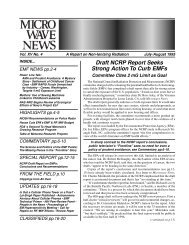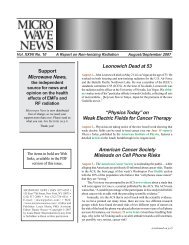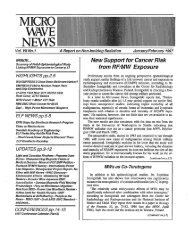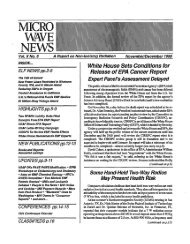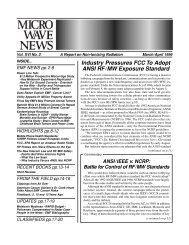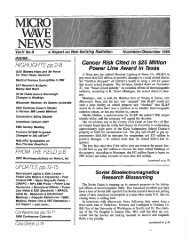Mobile Phones, Cancer Not Linked In Two Short ... - Microwave News
Mobile Phones, Cancer Not Linked In Two Short ... - Microwave News
Mobile Phones, Cancer Not Linked In Two Short ... - Microwave News
Create successful ePaper yourself
Turn your PDF publications into a flip-book with our unique Google optimized e-Paper software.
CLASSIFIEDS UPDATES<br />
VitaTech ech Engineering, LLC<br />
EMF Surveys, Exposure/Risk Assessments and<br />
Guaranteed Magnetic Shielding Solutions<br />
15414 Beachview Drive, Montclair, VA 22026<br />
(703) 670-8981 FAX: (703) 670-4974<br />
emf@vitatech.net www.vitatech.net<br />
Richard Tell Associates, <strong>In</strong>c.<br />
Electromagnetic Field Consulting and RF Safety Products<br />
8309 Garnet Canyon Lane<br />
Las Vegas, NV 89129-4897<br />
(702) 645-3338, Fax: (702) 645-8842<br />
E-mail: <br />
Web: <br />
Put Your Business Card in<br />
MICROWAVE NEWS<br />
Call Doug Barnes at (212) 517-2800<br />
EMF Papers<br />
A twice-monthly clipping service from MICROWAVE NEWS<br />
The perfect complement to your MWN subscription.<br />
Key government documents, abstracts of new<br />
papers, press releases. Plus…assorted clips.<br />
Direct to you, twice a month.<br />
$125.00 per month. Three-month minimum. Sample packet $25.00.<br />
Outside the U.S., please add $15.00 per month for airmail postage.<br />
MICROWAVE NEWS • PO Box 1799 • Grand Central Station<br />
New York, NY 10163 • (212) 517-2800 • Fax: (212) 734-0316<br />
Web: <br />
E-mail: <br />
Bookmark:<br />
www.microwavenews.com<br />
<strong>Microwave</strong> <strong>News</strong> Bound Volumes<br />
1996-2000 ($450.00)<br />
Also available at $450.00 each plus postage:<br />
___ 1981-1985 ___ 1986-1990 ___ 1991-1995<br />
Prepaid Orders Only. U.S. Funds or <strong>In</strong>ternational Money Order, Please.<br />
Visa and MasterCard Accepted.<br />
MICROWAVE NEWS • PO Box 1799 • Grand Central Station<br />
New York, NY 10163 • (212) 517-2800 • Fax: (212) 734-0316<br />
BROADCAST RADIATION<br />
Reassurance & Warnings on Sutton Coldfield...<strong>Two</strong> letters in<br />
the January 15 American Journal of Epidemiology (153, pp.202<br />
205, 2001) take opposite tacks on Dr. Helen Dolk’s 1997 epidemiological<br />
study of cancer and TV–radio signals from the Sutton<br />
Coldfield broadcast tower near Birmingham, U.K. (see MWN, J/<br />
F97). Dolk had found significant increases in leukemia risk among<br />
those living closest to the tower, but not around other antennas<br />
elsewhere in Britain. “Continuing local concern prompted a further<br />
study [of Sutton Coldfield] in which previous analysis was<br />
repeated andmoretimely cancer data were used,” write Drs. Duncan<br />
Cooper, Karla Hemmings and Pat Saunders of the University<br />
of Birmingham. “If the TV transmitter were a cause of adult<br />
leukemia, one would assume both a higher than background incidence<br />
in the areas...closest to the transmitter,” Cooper and colleagues<br />
write, “and a decline in risk with distance.” But their<br />
own study for 1987-1994 does not support Dolk’s results for<br />
1974-1986. A letter from Dr. Neil Cherry of Lincoln University<br />
in Canterbury, New Zealand, argues that Dolk’s study understates<br />
cancer risk because it did not take into account differences<br />
in radiation patterns from different antennas. <strong>In</strong> an accompanying<br />
comment, Dolk, of the London School of Hygiene and Tropical<br />
Medicine, writes that, “given the...imprecise risk estimates<br />
involved,” it is hard to say whether the new University of Birmingham<br />
data “are consistent with or contradict our findings.”<br />
MEDICAL DEVICE EMI<br />
Hospital Study: Cell <strong>Phones</strong> Can Zap Monitors...<strong>Mobile</strong><br />
phones can change the readings on hospital equipment, and can<br />
sometimes even make a device shut down. But the odds of such<br />
serious interference are very slim. Those are the conclusions of a<br />
study by Jeffrey Tri, Dr. David Hayes and colleagues at the Mayo<br />
Clinic in Rochester, MN. The study, published in the Mayo Clinic<br />
Proceedings (76, pp.11-15, 2001), tested 17 hospital devices with<br />
five different mobile phones, with the phones at a variety of distances<br />
and angles to the equipment. An accompanying editorial<br />
by two Mayo Clinic physicians states that the results “should<br />
give us pause”: Electromagnetic interference (EMI)was observed<br />
in 55% of the tests. <strong>In</strong> 7% of the tests, this interference was severe<br />
enough that it might be clinically important—that is, it could<br />
“hinder interpretation of the data or cause the equipment to malfunction.”<br />
Some sort of EMI was observed with 41% of the devices<br />
tested. The editorial, by Drs. David Herman and John Abenstein,<br />
singles out the case of a ventilator which shut down and<br />
restarted due to mobile phone EMI. “Even more alarming,” they<br />
write, “is the fact that the ventilator did not recover once the<br />
phone was...turned off.” The actual likelihood of this sort of interference<br />
is extremely small, state researchers Tri and Hayes: It<br />
occurred only when a phone was used within 5-10 cm of the<br />
ventilator’s communications port, which is located on the back<br />
of the machine and generally not accessible to patients or visitors.<br />
The most common type of EMI in this study was interference<br />
with an electrocardiogram readout. Noise on the baseline<br />
was the most common and was “generally produced by digital<br />
phones”; baseline movement was also observed and was mainly<br />
caused by analog models. The battery of tests included a “ring-<br />
MICROWAVE NEWS January/February 2001 16



